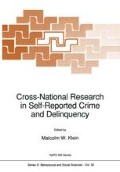Abstract
In epidemiology, the concepts of prevalence and incidence are central (Bradford Hill, 1977; Last, 1983; Morris, 1975). Basically, prevalence (or prevalence rate) refers to the number of diseases or spells of disease existing at a particular point in time or within a specified time period related to the total number of persons exposed to risk (a population or a defined group of people). Incidence (or incidence rate) on the other hand measures the rate of appearance of new cases in the group or population, i.e., the number of diseases/spells of disease beginning within a specified period of time related to the total number of persons exposed to risk during that period.1
Access this chapter
Tax calculation will be finalised at checkout
Purchases are for personal use only
Preview
Unable to display preview. Download preview PDF.
References
Ball, JC, Ross, A, & Simpson, A: Incidence and estimated prevalence of recorded delinquency in a metropolitan area. American Sociological Review 29:90–93, 1984.
Bradford Hill, A: A short texbook of medical statistics. London: Hodder & Stoughton, 1977.
Blumstein, A, & Cohen, J: Estimation of individual crime rates from arrest records. Journal of Criminal Law and Criminology, 70:561–585, 1979.
Blumstein, A, Cohen, J, & Farrington, DP: Criminal career research: Its value for criminology. Criminology 26:1–35, 1988.
Cooper, B, & Shepherd, M: Epidemiology and abnormal psychology. In Eysenck, HJ (Ed.), Handbook of abnormal psychology (2nd ed.). London: Pitman, 1972.
Eaton, WW: The sociology of mental disorders (2nd ed.). New York: Prager, 1986.
Elliott, DS, & Ageton, SS: Reconciling race and class differences in self-reported and official estimates of delinquency. American Sociological Review, 45:95–110, 1980.
Elliott, DS, & Huizinga, D: Social class and delinquent behavior in a national youth panel. Criminology, 21:149–177, 1983.
Empey, LT: American delinquency (rev. ed.). Homewood, 111.: Dorsey, 1982.
Farrington, DP: Age and crime. In Tonry, M, & Morris, N (Eds.), Crime and justice, Vol. 7. Chicago: University of Chicago Press, 1986.
Farrington, DP, Ohlin, LE, & Wilson, JQ: Understanding and Controlling crime. New York: Springer, 1986.
Gordon, RA, & Gleser, LJ: The estimation of prevalence of delinquency: Two approaches and a correction of the literature. Journal of Mathematical Sociology, 3:275–291, 1974.
Gottfredson, MR, & Hirschi, T: The true value of lambda would appear to be zero: An essay on career criminals, criminal careers, selective incapacitation, cohort studies, and related topics. Criminology, 24:213–233, 1986.
Hindelang, MJ, Hirschi, T, & Weis, JG: Measuring delinquency. Beverly Hills, CA: Sage Publications, 1981.
Hirschi, T, & Gottfredson, MR: Age and the explanation of crime. American Journal of Sociology, 89:552–584, 1983.
Last, JM (Ed.): A dictionary of epidemiology. New York: Oxford University Press, 1983.
Loeber, R, & Stouthamer-Loeber, M: Family factors as correlates and predictors of juvenile conduct problems and delinquency. In Tonry, M, & Morris, N (Eds.), Crime and justice, Vol. 7. Chicago: University of Chicago Press, 1986.
Morris, JN: Uses of epidemiology (3rd ed.). New York: McGraw-Hill, 1984.
Nettler, G: Explaining crime (3rd ed.). New York: McGraw-Hill, 1984.
Olweus, D: Aggression in the schools: Bullies and whipping boys. Washington, DC: Hemisphere, 1978.
Olweus, D: Stability of aggressive reaction patterns in males: A review. Psychological Bulletin, 86:852–875, 1979.
Olweus, D: Familial and temperamental determinants of aggressive behavior in adolescent boys: A causal analysis. Developmental Psychology, 16:644–660, 1980.
Olweus, D: Low school achievement and aggressive behavior in adolescent boys. In Magnusson, D, & Allen, VE (Eds.), Human development: An interactional perspective. New York: Academic Press, 1983.
Olweus, D: Aggressors and their victims: Bullying at school. In Frude, N, & Gault, H (Eds.), Disruptive behavior in schools. New York: Wiley, 1984.
Olweus, D: Bullying and harassment among school children in Scandinavia: Research and a nationwide campaign in Norway. Mimeo, 1987a.
Olweus, D: Bully/victim problems among school children in Scandinavia. In Myklebust, JP, & Ommundsen, (Eds.), Psykologprofesjonen mot ar 2000: Arbeidsliv, internasjonalisering og utdannelse. Oslo: Universitetsforlaget, 1987b.
Olweus, D: Bully victim problems in school: Basic knowledge and effects of an intervention program. In Rubin, K, & Pepler, D (Eds.), The development and treatment of childhood aggression. Hillsdale, NJ: Erlbaum, in press.
Olweus, D, & Endresen, J: Assessment of antisocial behavior in preadolescence and adolescence. Manuscript, in preparation.
Wilson, JQ, & Herrnstein, RJ: Crime and human nature. New York: Simon and Schuster, 1985.
Author information
Authors and Affiliations
Editor information
Editors and Affiliations
Rights and permissions
Copyright information
© 1989 Kluwer Academic Publishers
About this chapter
Cite this chapter
Olweus, D. (1989). Prevalence and Incidence in the Study of Antisocial Behavior: Definitions and Measurements. In: Klein, M.W. (eds) Cross-National Research in Self-Reported Crime and Delinquency. NATO ASI Series, vol 50. Springer, Dordrecht. https://doi.org/10.1007/978-94-009-1001-0_9
Download citation
DOI: https://doi.org/10.1007/978-94-009-1001-0_9
Publisher Name: Springer, Dordrecht
Print ISBN: 978-94-010-6940-3
Online ISBN: 978-94-009-1001-0
eBook Packages: Springer Book Archive

